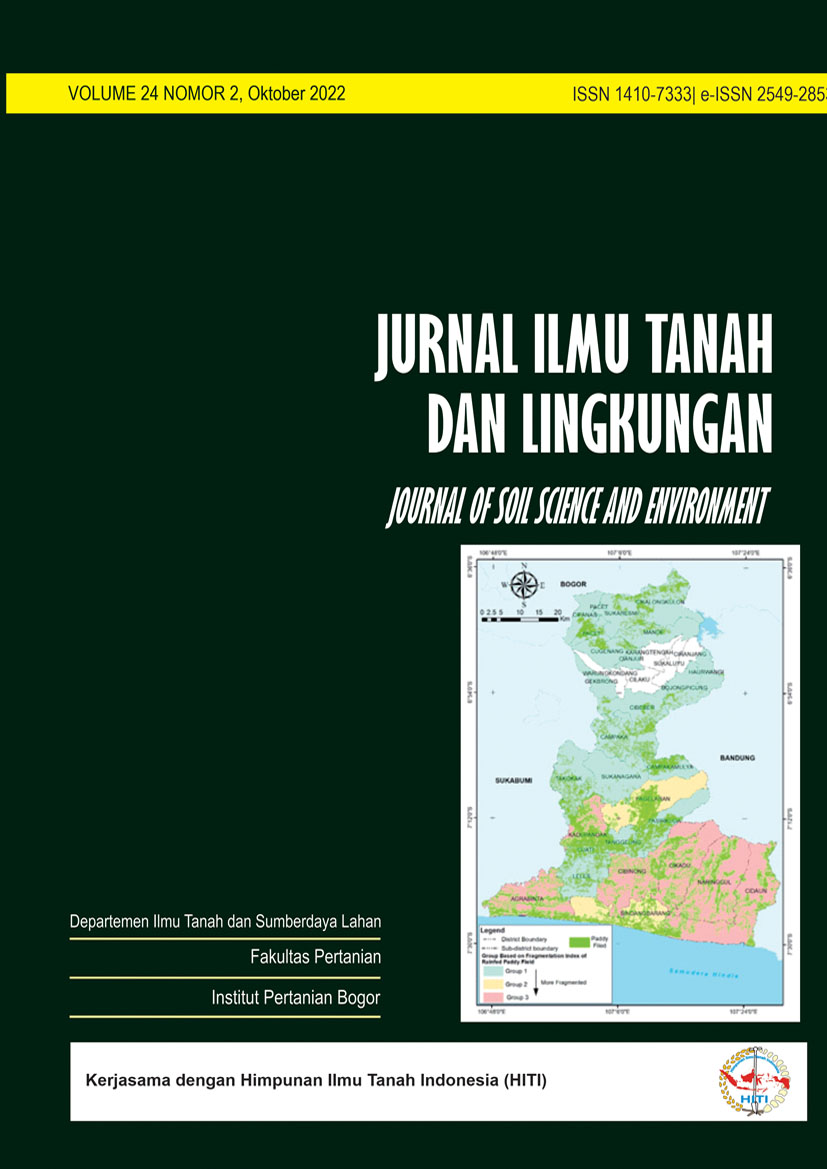PENGARUH MEDIA TANAM TERHADAP PERTUMBUHAN BIBIT TANAMAN CABAI (Capsicum annuum L) DAN INTENSITAS SERANGAN LAYU FUSARIUM (Fusarium oxysporum Schlecth) PADA PEMBIBITANNYA
The effect of growing media on the growth and intensity of Fusarium wilt due to Fusarium oxysporum in chilli (Capsicum annum) nursery
Abstrak
Berbagai jenis fauna dan flora yang berukuran makro, meso, maupun mikro hidup dan berkembang di dalam tanah. Keberadaan organisme tanah tersebut tidak selalu menguntungkan bagi pertumbuhan tanaman. Fusarium oxysporum merupakan salah satu cendawan merugikan yang hidup dan berkembang di dalam tanah yang dapat menyerang tanaman cabai. Hal ini menjadi salah satu faktor pembatas yang menyebabkan terjadinya penurunan produksi cabai dan gagal panen. Berbagai penelitian telah dilakukan untuk mengatasi masalah penyakit layu Fusarium misalnya dengan memusnahkan tanaman yang terserang penyakit, menggunakan fungisida hingga menggunakan agen hayati seperti Trichoderma sp. Namun masalah layu Fusarium belum dapat diatasi dengan baik. Berdasarkan hal tersebut penelitian ini dilakukan untuk mengetahui pengaruh perbaikan media pembibitan terhadap pertumbuhan tanaman dan intensitas serangan layu Fusarium pada tanaman cabai.
Hasil penelitian menunjukkan bahwa pengaruh media tanam dan pemberian Fusarium oxysporum tidak berpengaruh nyata terhadap tinggi tanaman cabai. Perlakuan AF1 (media tanam tanah saja yang diinokulasi dengan Fusarium) berpengaruh nyata terhadap jumlah daun dibandingkan perlakuan lainnya pada pengamatan 30 hari setelah tanam. Kejadian penyakit dan tingkat intensitas serangan penyakit paling tinggi terjadi pada perlakuan AF1 yaitu sebesar 71.43% kejadian penyakit dengan intensitas penyakit 53.57%. Sementara kondisi tanaman yang ditanam pada media lain mengalami tingkat kejadian penyakit dan intensitas penyakit yang rendah bahkan sehat. Hal ini menunjukkan bahwa penambahan arang sekam dan atau cocopeat berpengaruh nyata memberi hasil pertumbuhan yang lebih baik dan menghambat pertumbuhan cendawan Fusarium oxysporum karena fungsinya sebagai bahan organik mampu memperbaiki sifat fisik, kimia, dan biologi tanah sehingga pertumbuhan akar tanaman tetap baik meskipun media tanam telah terinfeksi cendawan Fusarium oxysporum.
Unduh
Referensi
Epp D. 1987. Somaclonal variation in banana: a case study with Fusarium wilt. In: Persley GJ, De Langhe EA (eds). Banana and Plantain Breeding Strategies. Canberra: ACIAR Publ. Pages 40-150.
Kementan [Kementerian Pertanian]. 2010. Standar Operasional Prosedur (SOP) Cabai Merah. Jakarta (ID): Direktorat Budidaya Tanaman Sayuran & Biofarmaka.
Martin FN. 2003. Development of alternative strategies for management of soil borne pathogens currently controlled with methyl bromide. Phytopathol. 41(1): 325-350.
Mulyaman S, Sukamto A, Kusmaryati, Damiati U. 2002. Hasil Identifikasi dan Pengendalian Organisme Pengganggu Tumbuhan (OPT) Tanaman Sayur. Dirjen Bina Produksi Hortikultura Direktorat Perlindungan Hortikultura.
Purwati RD, Hidayah N, Sudjindro, Sudarsono. 2008. Inoculation methods and conidial densities of Fusarium oxysporum f.sp.cubense in Abaca. Hayati Journal of Biosciences. 15(1):1-7.
Rochette, Angers PDA, Chantigny MH, Gagnon B, Bertrand N. 2006. In situ mineralization of dairy cattle manures as determined using soil-surface carbon dioxide fluxes. Soil Science Society of America Journal. 70:744-752.
Rostini N. 2011. 6 Jurus Bertanam Cabai Bebas Hama dan Penyakit. Jakarta (ID): PT AgroMedia Pustaka.
Sastrahidayat IR. 2011. Fitopatologi (Ilmu Penyakit Tumbuhan). Malang (ID):
Universitas Brawijaya Press.
Semangun H .2005. Penyakit-Penyakit Tanaman Hortikultura di Indonesia [Edisi 4] Yogyakarta (ID): Gadjah Mada University Press.
Solaiman ZM, Anawar HM. 2015. Application of biochars for soil constraints: challenges and solution. Pedosphere. 25(5): 631-638.
Soesanto L. 2008. Pengantar Pengendalian Hayati Penyakit Tanaman. Jakarta (ID): Raja Grafindo Persada.
Woltz SS, Jones JP. 1981. Nutritional requirements of Fusarium oxysporum: Basis for a disease control system. Pages 340-349.
##submission.copyrightStatement##
##submission.license.cc.by-sa4.footer##Departemen Ilmu Tanah dan Sumberdaya Lahan, Fakultas Pertanian, IPB University













